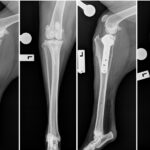Every day we see animals with significant dental disease. It is actually the most common health issue in cats and dogs. The Australian Veterinary Association, in conjunction with vets, is trying to clear up some of the common myths about dental disease in pets.
According to the AVA, the most common myths about dental disease are:
1. Myth – bad breath and tooth loss are inevitable in pets at any age
The truth – bad breath means infection. Dogs and cats lose teeth as a result of disease.
2. Myth – Dogs and cats don’t feel dental pain the way people do
The truth – If something is uncomfortable, unpleasant, or painful for us, it’s also painful for pets. Dogs and cats teeth have similar nerve supply to humans. Unfortunately unlike us, cats and dogs are very good at hiding signs of oral pain. It’s important to try and notice the more subtle signs to prevent prolonged infection and discomfort. This includes a reluctance to have the mouth handled, chewing on one side or swallowing food without chewing.
3. Myth – If my pet had oral disease surely I’d know!
The truth – Most owners don’t look in their pet’s mouth and even if they did they may not recognise the signs of disease.
4. Myth – Pet dentistry is really an elective or cosmetic procedure
The truth – Dental procedures are performed to treat existing problems and relieve pain and infection. Pets also hide pain so when dental treatment is recommended owners don’t understand that it’s for health and welfare reasons.
5. Myth – Scaling and polishing can be performed without general anaesthesia
The truth – Anaesthesia is an absolute requirement for dental procedures, including scaling and polishing. It’s not possible to examine all surfaces without general anaesthesia and if there’s any pathology or pain, it’s not humane for the patient without anaesthesia. Also, radiographs can’t be taken on a conscious animal. Finally, scaling and polishing without a protected airway carries risk of inhalation of water, bacteria and debris.
6. Myth – If we extract teeth, dogs and cats won’t be able to eat properly
The truth – Pets do fine without all their teeth and dental extraction is often the fastest way to resolve oral disease. In fact many pets eat much better after the source of infection and pain has been removed.
We recommend your pet having a full health check at least once every 12 months, but if you are concerned your pet may have dental disease, please phone us today for an appointment.



